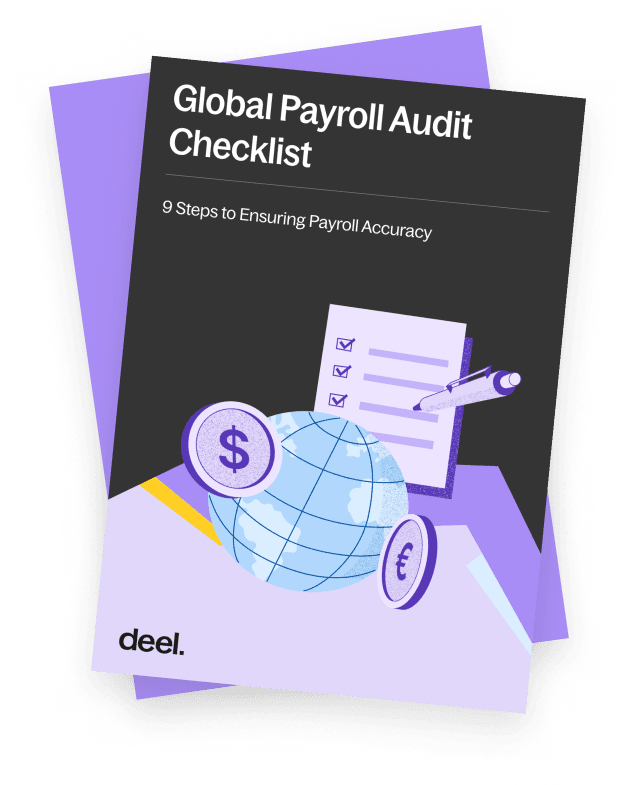Remote Work Glossary
- Results for "undefined"
Table of Contents
Why accrued payroll matters for your business
How to calculate accrued payroll (step by step)
Accrued payroll journal entries (with examples)
Common mistakes in accrued payroll accounting
Accrued payroll and compliance
Accrued payroll in global and remote workforces
Best practices for managing accrued payroll
Accrued payroll vs. cash basis payroll
Accrued payroll FAQs
Key takeaways
Simplifying accrued payroll with Deel
What is accrued payroll
Accrued payroll means the pay employees have earned but haven’t yet been paid. It also includes taxes and benefits linked to that pay.
In accounting, expenses are recorded when they happen, not just when money is paid out. If your staff works the last few days of December but gets paid in January, that unpaid work is still part of December’s expenses.
Accrued payroll covers:
- Hourly and salaried pay for work done but not yet paid
- Overtime or shift pay
- Bonuses and commissions earned
- Employer payroll taxes (like FICA or FUTA in the US)
- Accrued vacation or paid time off (PTO)
- Benefits such as insurance or retirement matches
Example:
If your pay period runs from December 22 – January 5, but the year ends December 31, you must record pay for December 22 – 31 as accrued payroll.
Why accrued payroll matters for your business
Accrued payroll keeps your books accurate by recording employee costs in the correct period, even if payment happens later.
Without accrued payroll, your financial statements may look better or worse than reality. You could show higher profits one month and lower profits the next, all because pay wasn’t recorded on time.
Why it’s important
- Accurate reporting: Matches labor costs to the period when employees worked.
- Better cash planning: Knowing what you owe helps manage cash flow.
- Audit compliance: Prevents gaps that auditors might flag.
- Transparency: Builds trust with employees and investors.
Example:
If your team earned $40,000 in December but you don’t pay until January, skipping the accrual makes December’s profit look $40,000 too high.

Checklist
Global Payroll Audit Checklist
How to calculate accrued payroll (step by step)
Add up unpaid wages, bonuses, and benefits earned before period end, then include employer payroll taxes.
Here’s how to do it clearly and consistently:
Step 1: Find unpaid workdays
List how many days in the pay period fall before the accounting cutoff.
Example: Pay period Dec 22 – Jan 5 → accrue 7 days for December.
Step 2: Calculate gross pay
- For hourly staff: unpaid hours × hourly rate
- For salaried staff: (annual salary ÷ working days) × unpaid days
Include overtime or bonuses already earned. Learn more about how to calculate gross to net pay.
Step 3: Add employer costs
Include payroll taxes, insurance, and any other company-paid benefits.
| Category | Hourly Staff A | Salaried Staff B | Total |
|---|---|---|---|
| Pay Type | Hourly | Salary | — |
| Unpaid Days | 7 | 7 | — |
| Daily Pay | $200 | $300 | — |
| Accrued Wages | $1,400 | $2,100 | $3,500 |
| Employer Taxes (10%) | $140 | $210 | $350 |
| Total Accrued Payroll | $1,540 | $2,310 | $3,850 |
Step 4: Record the total
Once calculated, record the amount as a liability in your accounting system.
Accrued payroll journal entries (with examples)
To record accrued payroll, debit wage expense and credit accrued payroll liability.
At the end of the period, create a payroll journal entry like this:
| Account | Debit | Credit |
|---|---|---|
| Wage Expense | $3,500 | — |
| Payroll Tax Expense | $350 | — |
| Accrued Payroll Liability | — | $3,850 |
When you pay employees, reverse the entry:
| Account | Debit | Credit |
|---|---|---|
| Accrued Payroll Liability | $3,850 | — |
| Cash | — | $3,850 |
Tip: Always reverse accruals at the start of the next period so payroll isn’t counted twice.

Common mistakes in accrued payroll accounting
Frequent errors include skipping partial periods, missing taxes or bonuses, and failing to reverse entries.
Typical issues include:
- Forgetting part of the pay period: Ignoring days between the last paycheck and month-end.
- Leaving out extras: Bonuses, commissions, or PTO aren’t accrued.
- Omitting employer costs: Taxes and benefits not included.
- Not reversing entries: Causes duplicate expenses.
- Over-accruing: Double-counting because payroll data isn’t synced.
Prevention checklist:
- Set month-end reminders.
- Reconcile accrual balances each month.
- Use connected payroll and accounting systems.
- Review with both payroll and finance teams.
Accrued payroll and compliance
Recording accrued payroll correctly supports tax, wage, and audit compliance under many reporting guidelines, such as GAAP and IFRS rules in the US.
Accrued payroll links HR operations to financial reporting. Done right, it meets key accounting and legal standards.
What to remember:
- Accounting rules: Many local authorities require recording expenses when incurred.
- Tax compliance: Employer contributions must be reported when earned.
- Labor laws: Some countries and states require timely wage recognition.
- Audit proof: Keep records of timesheets, pay registers, and journal entries.
Keeping your documentation organized will make audits faster and less stressful.

Accrued payroll in global and remote workforces
Global teams must manage accrued payroll across time zones, currencies, and different tax rules. Automation makes this much easier.
When your company has employees in several countries, accruals get tricky.
- Currency: Exchange rates change every month.
- Local pay cycles: Not every country uses the same payday.
- Different taxes: Each region has its own employer requirements.
- Consolidation: You should roll up results into one global report.
Example:
A company with staff in the US, UK, and Singapore closes its books on December 31. Each country has a unique pay schedule and tax deadline. Automating accruals saves days of manual work and ensures consistent reporting across entities.
Learn more: Your Ultimate Guide to International Payroll Processing
Best practices for managing accrued payroll
Regular checks, automation, and clear communication between payroll and finance keep accruals accurate and compliant.
To manage accrued payroll effectively:
- Use clear cutoff dates: Align payroll and finance calendars.
- Automate payroll where possible: Integrated systems reduce manual errors.
- Reconcile monthly: Check accrued amounts against actual payments.
- Keep detailed records: Store pay data, rates, and assumptions.
- Train your team: Make sure everyone understands accrual rules.
- Review reports: Dashboards help spot unusual balances early.
Quick monthly checklist:
☑ Verify unpaid days
☑ Calculate wages and employer taxes
☑ Record entries
☑ Reverse old accruals
☑ Review variance reports
Accrued payroll vs. cash basis payroll
Accrued payroll records pay when earned, while cash basis payroll records it when paid.
| Method | When Expense Is Recorded | Best For | Effect on Reports |
|---|---|---|---|
| Accrual | When employees earn pay | Most medium / large companies | More accurate, GAAP-compliant (in the US) |
| Cash | When employees are paid | Smaller businesses using simple books | Easier but less precise |
Accrual accounting gives a clearer picture of business performance because it matches labor costs to the right period. That’s why most audited companies use it.
Accrued payroll FAQs
Q: What’s the difference between accrued payroll and payroll payable?
Payroll payable is the liability account on the balance sheet. Accrued payroll is the process of calculating and recording that amount.
Q: How often should we record accrued payroll?
Usually every month-end or whenever a pay period crosses into a new month or fiscal year.
Q: Does accrued payroll include taxes and benefits?
Yes. It includes employee pay plus employer taxes and benefits owed.
Q: How do I reverse an accrued payroll entry?
At the start of the next period, debit the liability and credit the expense.
Q: Can payroll software handle accruals automatically?
Yes. Most modern systems calculate and post them based on schedules and rules you set.
Key takeaways
- Accrued payroll tracks what employees earned but haven’t been paid.
- It keeps financial reports accurate and compliant.
- The calculation includes wages, taxes, and benefits for unpaid days.
- Regular reviews and reversals prevent mistakes.
- Automation saves time and reduces errors.
Simplifying accrued payroll with Deel
Accrued payroll doesn’t have to be complicated. Still, managing it manually—especially across several countries—can take hours and lead to errors.
Deel Payroll automates payroll accruals across countries, currencies, and pay cycles. It connects time tracking, payroll, and accounting data so every earned dollar is captured and recorded automatically. With Deel, finance and payroll teams close faster, stay compliant, and see their payroll liabilities in real time.